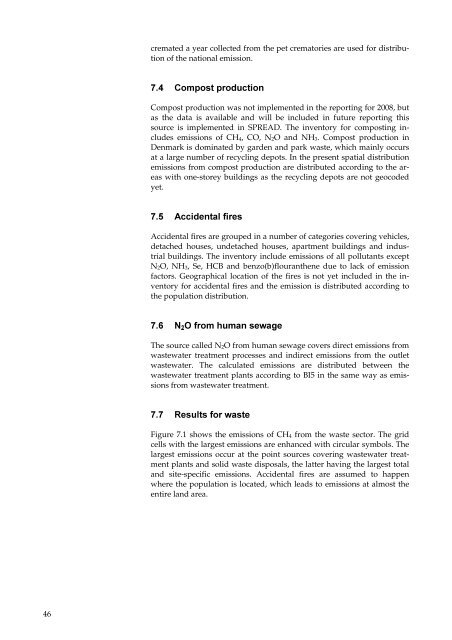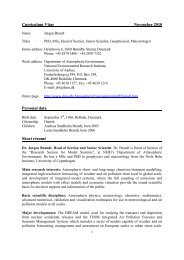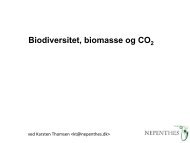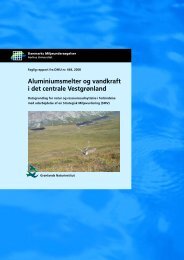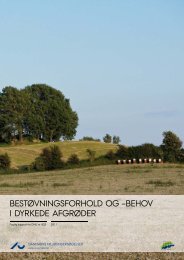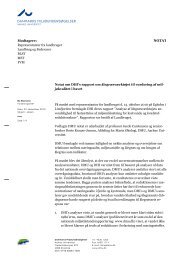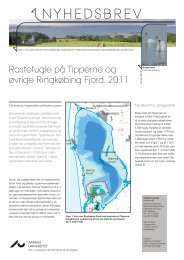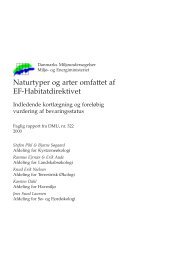Spatial distribution of emissions to air - the SPREAD model
Spatial distribution of emissions to air - the SPREAD model
Spatial distribution of emissions to air - the SPREAD model
Create successful ePaper yourself
Turn your PDF publications into a flip-book with our unique Google optimized e-Paper software.
46<br />
cremated a year collected from <strong>the</strong> pet crema<strong>to</strong>ries are used for <strong>distribution</strong><br />
<strong>of</strong> <strong>the</strong> national emission.<br />
&RPSRVW SURGXFWLRQ<br />
Compost production was not implemented in <strong>the</strong> reporting for 2008, but<br />
as <strong>the</strong> data is available and will be included in future reporting this<br />
source is implemented in <strong>SPREAD</strong>. The inven<strong>to</strong>ry for composting includes<br />
<strong>emissions</strong> <strong>of</strong> CH4, CO, N2O and NH3. Compost production in<br />
Denmark is dominated by garden and park waste, which mainly occurs<br />
at a large number <strong>of</strong> recycling depots. In <strong>the</strong> present spatial <strong>distribution</strong><br />
<strong>emissions</strong> from compost production are distributed according <strong>to</strong> <strong>the</strong> areas<br />
with one-s<strong>to</strong>rey buildings as <strong>the</strong> recycling depots are not geocoded<br />
yet.<br />
$FFLGHQWDO ILUHV<br />
Accidental fires are grouped in a number <strong>of</strong> categories covering vehicles,<br />
detached houses, undetached houses, apartment buildings and industrial<br />
buildings. The inven<strong>to</strong>ry include <strong>emissions</strong> <strong>of</strong> all pollutants except<br />
N2O, NH3, Se, HCB and benzo(b)flouran<strong>the</strong>ne due <strong>to</strong> lack <strong>of</strong> emission<br />
fac<strong>to</strong>rs. Geographical location <strong>of</strong> <strong>the</strong> fires is not yet included in <strong>the</strong> inven<strong>to</strong>ry<br />
for accidental fires and <strong>the</strong> emission is distributed according <strong>to</strong><br />
<strong>the</strong> population <strong>distribution</strong>.<br />
12 IURP KXPDQ VHZDJH<br />
The source called N2O from human sewage covers direct <strong>emissions</strong> from<br />
wastewater treatment processes and indirect <strong>emissions</strong> from <strong>the</strong> outlet<br />
wastewater. The calculated <strong>emissions</strong> are distributed between <strong>the</strong><br />
wastewater treatment plants according <strong>to</strong> BI5 in <strong>the</strong> same way as <strong>emissions</strong><br />
from wastewater treatment.<br />
5HVXOWV IRU ZDVWH<br />
Figure 7.1 shows <strong>the</strong> <strong>emissions</strong> <strong>of</strong> CH4 from <strong>the</strong> waste sec<strong>to</strong>r. The grid<br />
cells with <strong>the</strong> largest <strong>emissions</strong> are enhanced with circular symbols. The<br />
largest <strong>emissions</strong> occur at <strong>the</strong> point sources covering wastewater treatment<br />
plants and solid waste disposals, <strong>the</strong> latter having <strong>the</strong> largest <strong>to</strong>tal<br />
and site-specific <strong>emissions</strong>. Accidental fires are assumed <strong>to</strong> happen<br />
where <strong>the</strong> population is located, which leads <strong>to</strong> <strong>emissions</strong> at almost <strong>the</strong><br />
entire land area.


